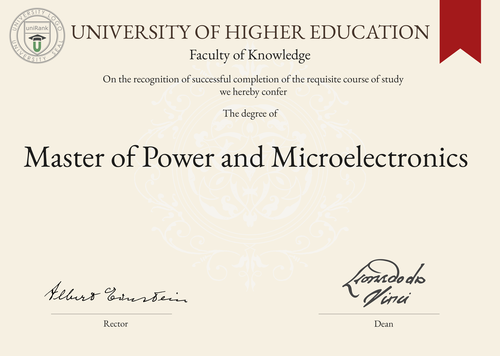
Master of Power and Microelectronics (M.P.M.)
Guide to Master of Power and Microelectronics Program/Course/Degree
Master of Power and Microelectronics (M.P.M.)

Program Name
Master of Power and MicroelectronicsProgram or Degree abbreviation
M.P.M.Duration range
The duration of the program typically ranges from 1 to 2 years.Tuition range
The tuition fees for the program vary depending on the chosen country and university. Please refer to the respective university's website for specific information.Overview
The Master of Power and Microelectronics program is designed to provide students with advanced knowledge and skills in the field of power systems and microelectronics. It focuses on the study of power generation, transmission and distribution, as well as the design and development of microelectronic devices and systems.Curriculum Overview by year
The curriculum is structured to cover both theoretical and practical aspects of power systems and microelectronics. The coursework is typically divided into the following areas: Year 1: - Introduction to Power Systems - Microelectronics Fundamentals - Power Electronics - Analog and Digital Integrated Circuits - Electromagnetic Compatibility - Control Systems Year 2: - Advanced Power Systems - Advanced Microelectronics - Power Semiconductor Devices - VLSI Design - Renewable Energy Systems - Project or ThesisKey Components
The key components of the program include: - Power Systems Analysis and Design - Microelectronics Circuit Design - Power Electronics and Drives - Semiconductor Devices - VLSI Design and Fabrication - Renewable Energy Systems - Control SystemsCareer Prospects
Graduates of the Master of Power and Microelectronics program can pursue various career opportunities in industries such as power generation, semiconductor manufacturing, telecommunications, automotive and renewable energy. They can work as power systems engineers, microelectronics engineers, research and development specialists, or consultants in both public and private sectors.Salary Expectations
The salary expectations for graduates of the program can vary depending on factors such as the country, industry, job position and level of experience. On average, professionals in the field of power and microelectronics can earn competitive salaries. For a more accurate understanding of salary expectations, you can utilize the Job Sites Search Engine, from our sister site jobRank, which searches over 4,600 job sites worldwide. Make sure to specify not only the job title but also the country you are interested in.Conclusions:
It is important to note that the duration, tuition fees, curriculum, key components, career prospects and salary expectations of the Master of Power and Microelectronics program can vary depending on the chosen country or location of study, as well as the chosen university. Prospective students are advised to research and compare different universities and countries to find the best fit for their academic and career goals. Visitors interested in pursuing the Master of Power and Microelectronics degree can search for universities offering this program worldwide through the uniRank World Universities Search Engine. This search engine provides comprehensive information on universities and their programs, allowing individuals to find the most suitable options for their educational needs.World Universities Search Engine
search for Master of Power and Microelectronics (M.P.M.) and add the Location (country, state etc.) or specific University you are interested in studying at.
Query examples:
- Master of Power and Microelectronics (M.P.M.) United States
- Master of Power and Microelectronics (M.P.M.) United Kingdom online
- Master of Power and Microelectronics (M.P.M.) Australia international students
- Master of Power and Microelectronics (M.P.M.) University of California
- Master of Power and Microelectronics (M.P.M.) University of London tuition fees
- Master of Power and Microelectronics (M.P.M.) University of Sydney scholarships
Share Program/Course
Interesting? Share this program/course/degree info with your friends now.